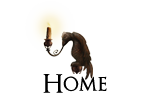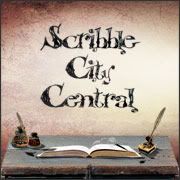Scribble City Central's lucky (but slightly delayed due to technical problems) thirteenth in the Fantabulous Fridays A-Z series is from Meg Rosoff, one of my all-time favourite authors, and winner of the Guardian Award for Children's Fiction and the Carnegie Medal. She's a writer who always surprises me, as a reader, with something new - and her latest book, There is No Dog, is no exception.
The idea of God as a hormonal teenage boy explains our random planetary weather and unexpected joys and disasters perfectly. However, it wasn't Bob/God who enchanted me most in this thought-provoking, funny novel. It was his Eck. I fell for the Eck hard. I wanted one in my life more than chocolate (a big want). He took up residence in the landscape of my mind as if he had always lived there, and (quite strangely) things then started disappearing out of my fridge - more than could be explained by having two teenagers in my house. The Eck, you see, is very greedy. Meg maintains that the Eck is now extinct - but I have uncorroborated evidence to the contrary (see rare fridge raid photo footage captured at great personal risk 'in the wild' by our own correspondent). Anyway, enough from me - I will now turn you over to the world's greatest living eckspert to tell you about:
E is for Eck
Fridge Raider of the Lost Ark
I give you...drumroll...MEG ROSOFF.
MR: It is an unfortunate fact that 90% of all animal and plant
species on the planet are now extinct, and tragically, the Eck is among them.
In contrast to the Dodo, nicknamed “Loathsome Bird” by the
Dutch Van Neck expedition in 1598 due to its greasy, disgusting-tasting flesh,
the Eck is thought to have become extinct due to having the most sublime
tasting flesh in nine thousand galaxies.
The deliciousness of Ecks has been corroborated by passages
in the poetry of Gong Zizhen, dating from the early Qin Dynasty in China (21
BC), recounting “banquets of Ecke which
did cause growne men to swoon uponeth the grounde with a moste embarrassing
excess of moaning.”
Early Celtic stone inscriptions from the 5th
century AD record a creature “the height
of a man’s hip with a nose long and flexible in shape and movement and a nature
most adorable and charming to whomsoever he shall befriend.” While of course every schoolchild knows that
the Eck appears with great frequency in the Bible, where it is described “always upon the right hand of God.” This description has been variously interpreted
to suggest the creature as advisor, guide, acolyte, servant, or even as a kind
of early Christian valet or pimp to the holiest of holy masters.
More recently, radical scholars of divinity have reinterpreted
the historical role of the Eck as closer to that of God’s domestic pet – more,
perhaps, like a Labrador Retriever in its capacity to offer comfort and
companionship, serving as “God’s best friend.”
By means of early hieroglyphic representations and fossil
remains, not to mention contemporary paintings, passport pictures and
photo-booth images, scientists can recreate the Eck with great accuracy as a
penguin-like creature, approximately 36” tall, with short legs, a scurrying
gait, and no tail. Ecks are mammals, give
birth to two or three fluffy grey live young at a time. Both parents are known to care for the young
(known as Ecksters) for the first two years of life, after which they are sent off
to forage for sandwiches on the high street.
Immature Ecks retain their fluffy juvenile coat throughout
the entire period of adolescence, developing the dense, wiry grey fur of a
mature Eck at the age of three. Ecks
were not traditionally hunted for their fur except during the great ice ages,
when humans were constantly chilly and, having dined on a delicious meal of
Eck, would put the fur to good use in the linings of slippers and bobble hats.
The last Eck was spotted as recently as 2011, but the
miracle of DNA cloning allows science and humanity to hope that a
reintroduction of the species may someday be accomplished.
SCC: Thank you so much for that fascinating insight into Eck history and biology, Meg. I have great hopes that the Eck may yet come out fighting from his (I hope temporary) extinction - there do seem to be more and more sightings worldwide, so I'm keeping my fingers firmly crossed.
Next week: Herbie Brennan, New York Times Bestselling Author and all-round good guy, is here to shine a spotlight on F for Faery (or Fairy, if you wish). See you then!
SCC: Thank you so much for that fascinating insight into Eck history and biology, Meg. I have great hopes that the Eck may yet come out fighting from his (I hope temporary) extinction - there do seem to be more and more sightings worldwide, so I'm keeping my fingers firmly crossed.
Next week: Herbie Brennan, New York Times Bestselling Author and all-round good guy, is here to shine a spotlight on F for Faery (or Fairy, if you wish). See you then!



































